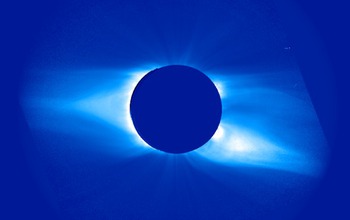Media Advisory 17-007
Solar Eclipse 2017 Media Event
NSF shares upcoming science plans as part of NASA Television event June 21 detailing the 'Great American Eclipse'

Total solar eclipses allow researchers a unique opportunity to study the sun's corona
June 13, 2017
This material is available primarily for archival purposes. Telephone numbers or other contact information may be out of date; please see current contact information at media contacts.
NSF will join several federal agencies and science organizations June 21 for two back-to-back briefings organized by NASA to provide important solar eclipse viewing safety, travel and science information.
For the first time in 99 years, a total solar eclipse will cross the nation Aug. 21. During the eclipse, the National Science Foundation (NSF) is funding research to learn more about the sun and space weather, including a citizen science project that will capture data about the sun at 68 sites along the path of the eclipse and an aircraft equipped with a special spectrometer that will acquire new data about the sun's corona.
The two briefings will that start at 1 p.m. EDT at the Newseum and stream live on NASA's website. Panelists will take questions from media in attendance or by phone. The public also can ask questions via social media during the briefings using the hashtag #eclipse2017. You can also follow #SolarEclipse2017 for updates, facts and other information from NSF.
EVENT DETAILS
| WHAT: | Two briefings on solar eclipse viewing safety, travel and science information. |
| WHO: | Representatives from NSF, NASA, NOAA, NPS, DOT, Montana Space Grant Consortium, University of Arizona, Astronomical Society of the Pacific, National Solar Observatory. |
| WHEN: | 1 p.m. EDT and 2:30 p.m. EDT on Wednesday, June 21 |
| WHERE: | Newseum's Knight Studio, 555 Pennsylvania Ave., NW. Event will also be livestreamed on NASA's website. |
| RSVP: | RSVP no later than 9 a.m. on June 21 to Andrew Schurr at (202) 358-0690 or andrew.d.schurr@nasa.gov. Please provide media affiliation. |
DETAILED AGENDA
Logistics Briefing: 1-2 p.m. EDT
- Thomas Zurbuchen, associate administrator, NASA Science Mission directorate
- Vanessa Griffin, director, NOAA Office of Satellite and Product Operations
- Brian Carlstrom, deputy associate director, Natural Resource Stewardship and Science, National Park Service
- Martin Knopp, associate administrator, Office of Operations, Dept. of Transportation
Science Briefing: 2:30-3:30 p.m. EDT
- Thomas Zurbuchen, associate administrator, NASA Science Mission directorate
- Angela Des Jardins, Eclipse Ballooning Project principal investigator, Montana Space Grant Consortium
- Angela Speck, professor of astrophysics and director of astronomy, University of Missouri
- Dave Boboltz, program director for solar physics, NSF's Division of Astronomical Sciences
- Linda Shore, executive director, Astronomical Society of the Pacific
- Matt Penn, astronomer at NSF's National Solar Observatory and principal investigator for the Citizen Continental-America Telescopic Eclipse (Citizen CATE) project
BACKGROUND
On Aug. 21, over the course of 100 minutes, 14 states across the United States will each experience more than two minutes of darkness in the middle of the day. Additionally, a partial eclipse will be observable across other parts of North America. You can see the path of the eclipse at the NSF National Solar Observatory's Citizen Cate web page.
The eclipse provides a unique opportunity to study one of the hardest-to-observe parts of the sun: its corona. The corona is the upper level of the sun's atmosphere and the source of sun's most violent activity (e.g., coronal mass ejections, flares and filaments) which in turn affects space weather and impacts communications systems, satellites, power grids and more on Earth.
The briefings will be held in the Newseum's Knight Studio, located at 555 Pennsylvania Ave., N.W. Space is limited. Media planning to attend must RSVP and provide their media affiliation.
The NSF National Solar Observatory website has additional information on the eclipse and how to safely view it.
-NSF-
Media Contacts
Ivy F. Kupec, NSF, (703) 292-8796, email: ikupec@nsf.gov
Karen Fox, National Aeronautics and Space Administration, (202) 358-1726, email: karen.c.fox@nasa.gov
Dwayne Brown, National Aeronautics and Space Administration, (202) 358-1726, email: dwayne.c.brown@nasa.gov
The U.S. National Science Foundation propels the nation forward by advancing fundamental research in all fields of science and engineering. NSF supports research and people by providing facilities, instruments and funding to support their ingenuity and sustain the U.S. as a global leader in research and innovation. With a fiscal year 2023 budget of $9.5 billion, NSF funds reach all 50 states through grants to nearly 2,000 colleges, universities and institutions. Each year, NSF receives more than 40,000 competitive proposals and makes about 11,000 new awards. Those awards include support for cooperative research with industry, Arctic and Antarctic research and operations, and U.S. participation in international scientific efforts.
Connect with us online
NSF website: nsf.gov
NSF News: nsf.gov/news
For News Media: nsf.gov/news/newsroom
Statistics: nsf.gov/statistics/
Awards database: nsf.gov/awardsearch/
Follow us on social
Twitter: twitter.com/NSF
Facebook: facebook.com/US.NSF
Instagram: instagram.com/nsfgov


